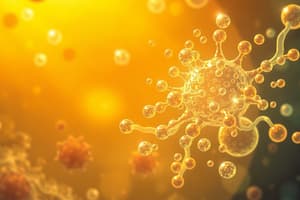Podcast
Questions and Answers
Which method allows for both enumeration and biochemical testing of microorganisms?
Which method allows for both enumeration and biochemical testing of microorganisms?
- Culturing (correct)
- Indirect methods
- Immunological methods
- Molecular biology
Complex media have an exact and known chemical composition.
Complex media have an exact and known chemical composition.
False (B)
What is the primary assumption made when enumerating microorganisms on a plate, concerning the origin of each colony?
What is the primary assumption made when enumerating microorganisms on a plate, concerning the origin of each colony?
Each colony arises from a single bacterial or yeast cell in the original liquid.
In immunological methods, an __________ is a molecular marker on the microorganism that is unique to that organism.
In immunological methods, an __________ is a molecular marker on the microorganism that is unique to that organism.
Match the media type with its primary characteristic:
Match the media type with its primary characteristic:
Which of the following best explains why a scientist might choose to use molecular biological methods over traditional culturing methods for detecting microorganisms?
Which of the following best explains why a scientist might choose to use molecular biological methods over traditional culturing methods for detecting microorganisms?
A count of 25 colonies on a $10^{-6}$ dilution plate is within the countable range and acceptable for accurate enumeration.
A count of 25 colonies on a $10^{-6}$ dilution plate is within the countable range and acceptable for accurate enumeration.
What does CFU stand for, and why is it used in the context of enumerating microorganisms?
What does CFU stand for, and why is it used in the context of enumerating microorganisms?
__________ assays can be used in immunological methods for qualitative or ELISA for __________ testing.
__________ assays can be used in immunological methods for qualitative or ELISA for __________ testing.
Match each term with its appropriate description in the context of microbial detection:
Match each term with its appropriate description in the context of microbial detection:
Which consideration is most critical when choosing a suitable media for culturing microorganisms?
Which consideration is most critical when choosing a suitable media for culturing microorganisms?
Using a selective media guarantees that all types of bacteria will grow, but only certain types will be easily distinguishable.
Using a selective media guarantees that all types of bacteria will grow, but only certain types will be easily distinguishable.
When performing serial dilutions for plate counts, a $10^{-4}$ dilution yields 37 colonies. What is the CFU/mL in the original sample?
When performing serial dilutions for plate counts, a $10^{-4}$ dilution yields 37 colonies. What is the CFU/mL in the original sample?
__________ agar is an example of a media that is both selective and differential, as it allows only gram-negative bacteria to grow and differentiates based on lactose fermentation.
__________ agar is an example of a media that is both selective and differential, as it allows only gram-negative bacteria to grow and differentiates based on lactose fermentation.
Match the following methods with their principle of detection:
Match the following methods with their principle of detection:
Why are serial dilutions necessary when enumerating microorganisms?
Why are serial dilutions necessary when enumerating microorganisms?
The primary advantage of using defined media over complex media is the lower cost, making it more suitable for large-scale experiments.
The primary advantage of using defined media over complex media is the lower cost, making it more suitable for large-scale experiments.
What is the significance of titratable acidity as an indirect method for detecting microorganisms, and in what sample is it commonly used?
What is the significance of titratable acidity as an indirect method for detecting microorganisms, and in what sample is it commonly used?
The use of __________ methods can detect the presence of specific microorganisms by targeting their DNA or RNA.
The use of __________ methods can detect the presence of specific microorganisms by targeting their DNA or RNA.
Match the following dilution factors with their corresponding CFU/mL calculation, given a colony count of 50:
Match the following dilution factors with their corresponding CFU/mL calculation, given a colony count of 50:
Flashcards
Culturing Microorganisms
Culturing Microorganisms
Growing microorganisms on a suitable media in a petri dish.
Selective media
Selective media
Media that allows certain bacteria to grow while inhibiting others.
Differential media
Differential media
Media that allows many bacteria to grow, highlighting differences between them.
Enumeration of Microorganisms
Enumeration of Microorganisms
Signup and view all the flashcards
Defined Media
Defined Media
Signup and view all the flashcards
Complex Media
Complex Media
Signup and view all the flashcards
Polymerase Chain Reaction (PCR)
Polymerase Chain Reaction (PCR)
Signup and view all the flashcards
Antigen
Antigen
Signup and view all the flashcards
Antibody
Antibody
Signup and view all the flashcards
Indirect Methods
Indirect Methods
Signup and view all the flashcards
CFU (Colony Forming Units)
CFU (Colony Forming Units)
Signup and view all the flashcards
Colony origin
Colony origin
Signup and view all the flashcards
Study Notes
- Methods for detecting, identifying, and counting microorganisms in food include culturing, molecular biology, immunological methods, and other techniques.
Culturing Microorganisms
- Requires growing organisms on a suitable medium, such as in a petri dish.
- Different microorganisms have different growth requirements.
- Various media, growth temperatures, and atmospheres can support the growth of different microorganisms.
- Culturing can be selective, differential, or both.
- This method enables enumeration and biochemical testing.
Selective vs. Differential Media
- Selective media allows only certain bacteria to grow.
- Differential media allows many bacteria to grow, with the ability to distinguish characteristics; for example, blood agar distinguishes bacteria that break down red blood cells.
- MacConkey agar is a medium where only gram-negative bacteria grow (selective), and bacteria that can ferment lactose appear pink (differential).
Enumeration of Microorganisms
- Involves growing organisms in a suitable medium at different dilutions and counting colonies after a growth period of 1-3 days, typically with 1 mL of media plated.
- Assumes each colony on a plate originates from a single bacterial or yeast cell in the original liquid.
- Results are reported in CFU (colony forming units) per mL in the original sample.
- The countable range is 30-300 colonies, where results can be reported if the plate count is less than 30, estimated. If greater than 300, it is considered too numerous to count.
Defined vs. Complex Media
- Defined media has a known chemical composition and is used for metabolic experiments, more difficult to make.
- Complex media has an unknown exact chemical composition.
- Complex media contains ingredients like casein digest, soybean digest, and yeast extracts and is easier to make.
Molecular Biological Methods
- Polymerase chain reaction (PCR) can detect DNA or RNA of specific organisms.
- Molecular methods can be used for identification or quantification and are faster than culturing methods.
Immunological Methods
- Antigens are molecular markers unique to a microorganism.
- Antibodies recognize these molecular markers.
- Lateral flow assays are used for qualitative testing, while ELISA is used for quantitative testing.
Other Detection Methods: Indirect Methods
- Measures a characteristic related to microbial activity in a time-efficient manner.
- Titratable acidity in milk is an example.
Studying That Suits You
Use AI to generate personalized quizzes and flashcards to suit your learning preferences.




